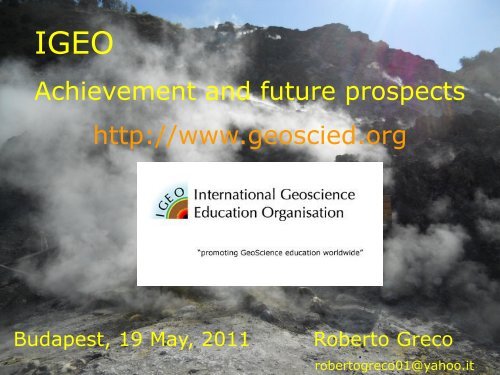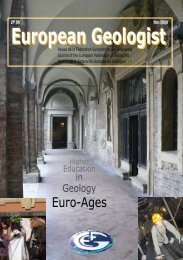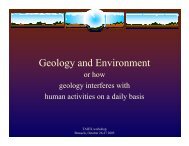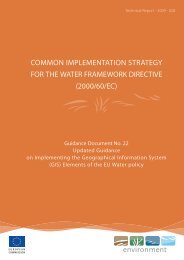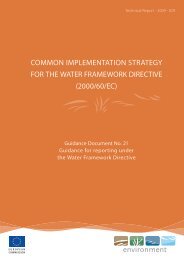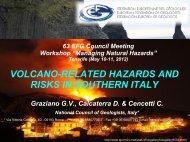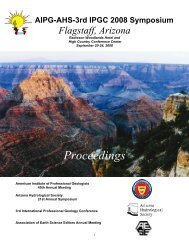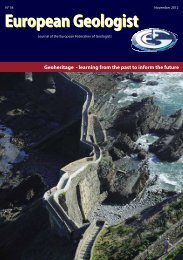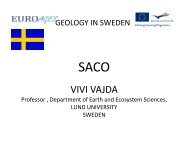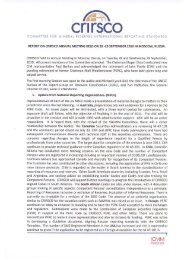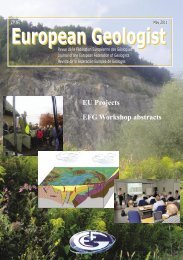Roberto Greco
Roberto Greco
Roberto Greco
Create successful ePaper yourself
Turn your PDF publications into a flip-book with our unique Google optimized e-Paper software.
IGEOAchievement and future prospectshttp://www.geoscied.orgBudapest, 19 May, 2011<strong>Roberto</strong> <strong>Greco</strong>robertogreco01@yahoo.it
The aims of IGEO are:-to promote geoscience education internationallyat all levels,- to work for the enhancement of the quality ofgeoscience education internationally- to encourage developments raising publicawareness of geoscience, particularly amongstyounger people.Budapest, 19 May, 2011<strong>Roberto</strong> <strong>Greco</strong>
To reach these goals, the IGEO monitorsinternational geoscience education worldwideand fosters communication between geoscienceeducators. The organisation strives to create anetwork with international and national bodiesconcerned with geoscience education, withinternational professional geoscience bodies,such as the International Union of GeologicalSciences (of which it is an affiliate)and with international bodiesconcerned with science education.Budapest, 19 May, 2011<strong>Roberto</strong> <strong>Greco</strong>
Budapest, 19 May, 2011<strong>Roberto</strong> <strong>Greco</strong>
IGEO is led by a Council formed from onemember from each interested country and adeputy member. Council meetings are heldbiannually as part of the program for theInternational Geoscience Congress (IGC) and theGeoSciEd conferences. At the moment, 34countries are represented with council membersIGEO runs an international Conferenceapproximately every four years, alternating witha representation at the International GeologicalCongress, which also takes place at four yearintervals.Budapest, 19 May, 2011<strong>Roberto</strong> <strong>Greco</strong>
OrganisationThe Organisation shall be lead by a Council.Council CompositionThe Council shall consist of an appropriate number of persons,appointed as follows:a. OfficersA Chairperson;A Vice-Chairperson;A Secretary/Treasurer;A Newsletter Editor;Convenor of next Conferenceb. CommitteeOne member from each country seeking representation on theCouncil, up to a maximum number to be determined by theCouncil.Budapest, 19 May, 2011<strong>Roberto</strong> <strong>Greco</strong>
Budapest, 19 May, 2011<strong>Roberto</strong> <strong>Greco</strong>
Budapest, 19 May, 2011<strong>Roberto</strong> <strong>Greco</strong>
The International Geoscience Education Organisation(IGEO) was formed on Tuesday 18 January 2000 atthe 3 rd International Conference on GeoscienceEducation in Sydney, Australia1993 – GeoSciEd I, Southampton, UK1997 – GeoSciEd II, Hawaii, USA2000 – GeoSciEd III, Sidney, Australia2003 – GeoSciEd IV, Calgary, Canada2006 – GeoSciEd V, Bayreuth, Germany2010 – GeoSciEd VI, Johannesburg, South Africa2014 - GeoSciEd VII, Bangalore, IndiaBudapest, 19 May, 2011<strong>Roberto</strong> <strong>Greco</strong>
2003 – GeoSciEd IV, Calgary, Canada. Delegates atthe Royal Tyrrell Museum of Palaentology,Drumeler, Alberta. Photo: Alan MorganBudapest, 19 May, 2011<strong>Roberto</strong> <strong>Greco</strong>
2006 – GeoSciEd V, Calgary, Canada. Delegates.Photo: Alan MorganBudapest, 19 May, 2011<strong>Roberto</strong> <strong>Greco</strong>
2010 – GeoSciEd VI, Johannesburg, South Africa.Delegates. Photo: <strong>Roberto</strong> <strong>Greco</strong>Budapest, 19 May, 2011<strong>Roberto</strong> <strong>Greco</strong>
Session titles• best practice in geoscience education• geoscience education research• geoscience education in the real world• teaching difficult and/or controversial geoscience topics• geoscience education in informal settings• global comparison• general science education session• promoting diversity in geosciences• using computers and multimedia to teach about thegeosciences• geoherithage• different social, economic and political contexts• using Earth science olympiads as a tool to promotegeoscience education
Building capacity in education in the developing world4-5 September 2011, Johannesburg (South Africa)Budapest, 19 May, 2011<strong>Roberto</strong> <strong>Greco</strong>
Earth Learning Ideawww.earthlearningidea.com
Budapest, 19 May, 2011<strong>Roberto</strong> <strong>Greco</strong>
Budapest, 19 May, 2011<strong>Roberto</strong> <strong>Greco</strong>
Budapest, 19 May, 2011<strong>Roberto</strong> <strong>Greco</strong>
Name, acronym and websiteInternational Mathematical Olympiad –IMOhttp://www.imo-official.org/International Phisics Olympiad – IPhOhttp://www.jyu.fi/ipho/International Chemistry Olympiad –IChO http://www.icho.sk/International Olympiad in Informatics –IOI http://www.ioinformatics.orgInternational Biology Olympiad –IBOhttp://www.ibo-info.org/International Astronomy Olympiad –IAO http://www.issp.ac.ru/iao/International Geography Olympiad –iGeO http://www.geoolympiad.org/International Junior Science Olympiad(under 15 years old) – IJSOhttp://www.ijso-fficial.org/homeInternational Olympiad on Astronomyand AstrophysicsIOAAhttp://ioaa.info/ioaa2007/Country where wasFirstheld the firsteditionedition1959 Romania 118Partecipantcountries2010Netherland1967 Poland 80 Thailand1968 Czechoslovakia 71 Turkey1989 Bulgaria 84 Thailand1990 Czechoslovakia 59 Taiwan1996 Russia 19 (in 2008) Bulgaria1996 Netherland 22 German (2012)2004 Indonesia 49 (2009) South Africa2007 Thailand 22 PolandinCountry guest in2011International Earth Science Olympiad -IESO http://www.ieso2009.tw2007Republic of Corea 18ItalyBudapest, 19 May, 2011<strong>Roberto</strong> <strong>Greco</strong>
Previous and future editions•2007 – 1st edition – Republic of Korea, topic: Earth for Life, Universefor future Life2008 – 2nd edition – Philippine, topic: Cooperationin Addressing Climate Changes•2009 – 3rd edition – Taiwan, topic: Human and Environment•2010 – 4th edition – Indonesia, topic: The Present is the Key to the Future•2011 – 5th edition – Italy, topic: Earth Science Renaissance: Science,Environment and Art•2012 – 6th edition – ??? (maybe Argentina)•2013 – 7th edition – India
The figure below shows a type of landform which consists ofsand.What is the most likely prevailing local wind direction? (1 pt)(A) from low right to upper left (B) from upper right to lowerleft(C) from upper left to lower right (D) from lower left to upperright(E) no prevailing wind direction can be identified(C)(B)(A)(D)
Budapest, 19 May, 2011<strong>Roberto</strong> <strong>Greco</strong>
Budapest, 19 May, 2011<strong>Roberto</strong> <strong>Greco</strong>
Budapest, 19 May, 2011<strong>Roberto</strong> <strong>Greco</strong>
Budapest, 19 May, 2011<strong>Roberto</strong> <strong>Greco</strong>
Budapest, 19 May, 2011<strong>Roberto</strong> <strong>Greco</strong>
Budapest, 19 May, 2011<strong>Roberto</strong> <strong>Greco</strong>
Budapest, 19 May, 2011<strong>Roberto</strong> <strong>Greco</strong>
Budapest, 19 May, 2011<strong>Roberto</strong> <strong>Greco</strong>
Budapest, 19 May, 2011<strong>Roberto</strong> <strong>Greco</strong>GIFT Wien, 05 April 2011, roberto.greco@unimore.it http://www.ieso2011.unimore.it
Budapest, 19 May, 2011<strong>Roberto</strong> <strong>Greco</strong>
Budapest, 19 May, 2011<strong>Roberto</strong> <strong>Greco</strong>
IESO 2011 we will aspect:47 countries33 with students65 mentors134 students41 observer12 guestBudapest, 19 May, 2011<strong>Roberto</strong> <strong>Greco</strong>
Thank youfor your attention!Budapest, 19 May, 2011<strong>Roberto</strong> <strong>Greco</strong>


